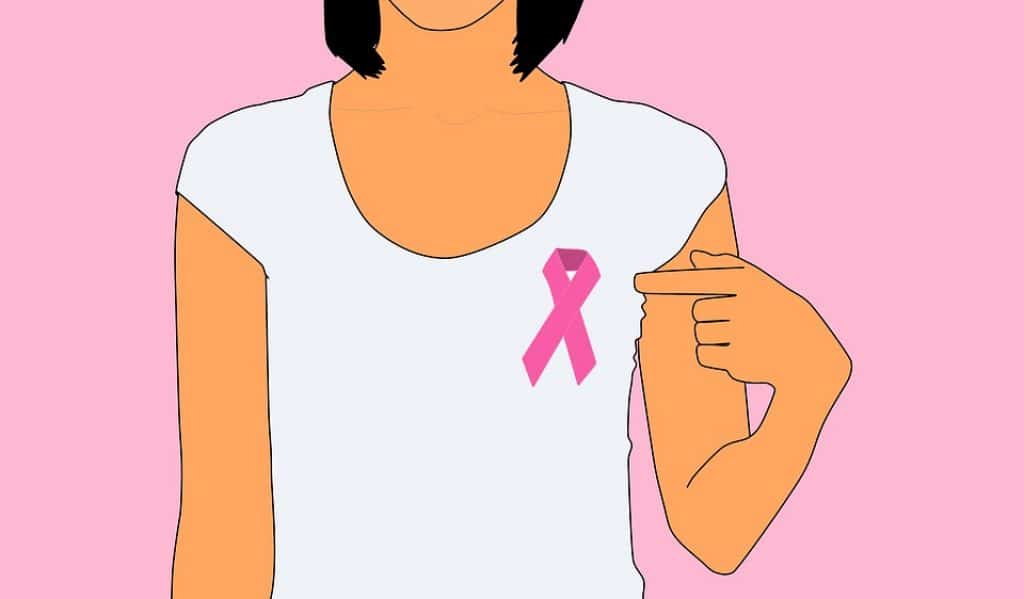Breast cancer is one of the very common types of cancer. If we talk about the statistics; breast cancer represents one in four of all cancers in women. It means that out of four female cancer patients one suffers from breast cancer. Another horrifying fact says that the numbers of breast cancer cases are increasing. It is the most common cancer in American females, after skin cancer. In India also, this cancer has rank number one among the all types of cancers in the female. The good thing is that at an early stage this cancer can be curable but still India has a very low breast cancer survival rate in patients.
Usually, people think that breast cancer can occur only to females, but it’s not true. Breast cancer can occur to both males and females, but it’s very common in women in comparison of men.

Must Read Types of Cancer Treatment
Sign and Symptoms of Breast Cancer
Breast cancer can be curable easily only if it is diagnosed at its earlier stage. So, it is really important to not to ignore any sign of discomfort at your breast or armpit area. Warning signs for this cancer can vary from person to person. Symptoms of breast cancer depend on the stage and type of cancer. Here, we will share a few early signs of breast cancer.
- If you feel any sort of nipple discharge, don’t ignore it. It’s one of the first signs of uneasiness in your breast.
- Any change in the color of the nipple or its look or feel can be an early sign of breast cancer.
- Any change in look, skin color, but feel of the breast can be an alarming sign.
- While checking your breast if you find any lump or some inside thickness or a hard knot inside your breast or armpit area doesn’t ignore it and visit your doctor.
- If you see color changes in your breast do not take it lightly. The red color of your breast’s skin, any rash or crusting of the nipple or surrounding area can also be a sign of breast cancer.
It’s really important to check your breasts regularly. You can check your breasts once a month. You could check it while you are in the shower or before bed. Proper check-up of breasts includes the whole breast, nipple, and armpit area.
Read also Top10 Cancer Fighting Foods
Risk Factors for Breast Cancer
- A higher rate of alcohol consumption.
- High sugar intake and being overweight.
- High estrogens level.
- Because of genes. If any close relative has or had breast cancer.
- The risk grows with the age.
- Exposure to radiation.
- Oral birth control pills or hormone replacement therapy.
How Does Breast Cancer Start?
Breast cancer forms from the cells of the breasts. When cells from the breasts start to grow and this growth became out of control, it can form breast cancer. These cells form a tumor and this tumor can be felt like a lump. It can happen at any part of the breasts. A breast has three main parts;
- Lobules: These are the glands and their main work is to produce milk.
- Ducts: Ducts look like tubes and they carry milk to the nipple.
- Connective Tissues: Connective tissues are responsible to hold everything together.
Breast cancer usually begins with lobules or ducts.
Types of Breast Cancer
To understand the different types of breast cancers, we will divide them into the following categories; Common breast cancer types, rare breast cancer types, and breast cancer molecular subtypes.
Common Breast Cancer Types
- Invasive breast cancer: In Invasive (infiltrating) breast cancer, the cancer cells grow outside the ducts and spread to other parts of the body through the bloodstream and lymph nodes. These cells can metastasize to other parts of the body. This type of breast cancer affects men too.
- Non-invasive breast cancer: In this type of breast cancer, the cancerous cells are found in the lining of the breast milk duct. It is a very early stage of breast cancer and if it is left untreated then it can spread into other breast cells. At this stage, the cancer is highly treatable.
Rare Breast Cancer Types
- Paget’s disease of the breast: This is a rare type of breast cancer. In this type of cancer, the cancer cells accumulate in the ducts but may be extended to the nipple surface. At the initial stage, Paget’s disease can confuse the patient with some skin disease because in this condition the skin color and thickness of the nipple changes to red, and sometimes it is accompanied by discharge from nipples or a burning sensation.
- Inflammatory breast cancer: This is also a rare type of breast cancer. It occurs only in 4% of breast cancer cases. This cancer occurs comparatively at a younger age. In most cases of this type of cancer, the breast becomes red, swollen, and feels heavier. The breast skin became warm, feels thick and it may have an orange peel’s appearance.
- Male breast cancer: As we have mentioned above that males can also develop breast cancer cells. This can be possible because men also have breast tissues. These tissues develop in the same way as they develop in women’s bodies. In females, during puberty, their breasts grow but in males, it doesn’t happen because of their hormones. In men, breast cancer may begin in the ducts and can spread to surrounding cells. There are a few cases, where it has been seen that men’s breast develops inflammatory breast cancer and Paget’s disease of the breast too.
- Metastatic breast cancer: Metastatic breast cancer is a type of breast cancer that spreads to other parts of the body. It is also called stage 4 breast cancer. In this type of cancer, the cancer cells travel to other parts of the body through different mediums like the bloodstream or the lymphatic system. The liver, lungs, brain, or bones are the different body parts that are commonly get affected by this cancer. In many cases (around 30%) women diagnosed with early-stage breast cancer will develop this type of cancer later on. Very recently, one Indian celebrity Sonali Bendre has diagnosed with metastatic cancer.
- Papillary Carcinoma: This is one of the very rare types of breast cancer, accounting for three percent of all types of breast cancers. Here the word ‘papillary’ refers to ‘nipple-like’. In most of the cases of papillary breast cancer, it occurs at the beneath of the nipple and resulted in a bloody nipple discharge. In this type of cancer, cells are arranged in a finger-like projection of papules and look like a fern under the microscope. The shape of these cells is the primary difference between papillary carcinoma and other types of breast cancers.
Breast Cancer Stages and their Treatment
Stages of breast cancer describe its extent within the patient’s body. Based on the stage of breast cancer, the patient gets the treatment. Breast cancer stages are calculated on a scale of 0 to 4. Stage 0 is the earliest stage of cancer and stage 4 is the highest stage of cancer. TNM is the most widely used method for staging cancer. Here T stands for Tumor size, N for Lymph Node status (it shows the presence of cancer in lymph nodes), and M stands for Metastases (it shows the spreaders of cancer in other parts of the body).
Stage 0:
Stage 0 describes non-invasive breast cancer such as ‘Ductal carcinoma in situ (DCIS)’ & ‘Lobular carcinoma in situ’ (LCIS). LICS in stage 0 is generally not considered as cancer. But it increases the risk of developing breast cancer cells. It is non-invasive cancer. In this stage, the infected cells remain inside the ducts or lobules. Stage 0 of cancer is highly treatable.
Treatment at stage 0:
Following options are used as the treatment of cancer at this stage.
- Surgery
- Radiation therapy
- Hormone Treatment (it is used to lowering the case of developing invasive breast cancer)
Stage 1:
this stage cancer is for invasive cancer. Stage 1 breast cancer is further divided into two groups.
Stage 1A: This stage describes that a tumor has reached a size of approximately 2 cm. It is as small as a peanut and hasn’t spread to the lymph nodes.
Stage 1B: Stage 1B describes the small areas of the breast or lymph nodes that have cancer evidence. In this stage, two possibilities may happen. Either of no tumors in the breast but a cluster of cancer cells (no larger than 2 millimeters) or there is a tumor in the breast (no larger than 2 centimeters).
As stage 0 of breast cancer, stage 1 is also highly treatable.
Treatment at stage 1:
Following options are used as the treatment of cancer at this stage.
- Surgery
- Radiation therapy (sometimes suggested after surgery)
- Hormone therapy
- Chemotherapy (almost always needed)
Stage 2:
In stage 2 of breast cancer, either the cancer is still within the breast or it has grown to the nearby lymph nodes. Stage 2 breast cancer is further divided into two categories.
Stage 2A: Stage 2A describes one of the following conditions.
- There is no tumor in the breast but cancer cells are present in not more than four lymph nodes under the arm (axillary lymph node) or the lymph nodes near the breastbone. According to another condition of breast cancer Stage 2A, there can be a tumor not larger than 2 cm and has spread to the axillary lymph node.
- In another condition, the tumor can be larger than 2 cm but smaller than 5 cm and has not affected any lymph nodes.
Stage 2B: Stage 2B means one of the following conditions.
- In this stage, the tumor is larger than 2 cm but smaller than 5 cm and has affected the small group of breast cancer cells (not more than 2 mm).
- When a tumor is bigger than 5 cm but cancer cells have not traveled to any lymph node it is breast cancer stage 2B.
Treatment at stage 2:
Following options are used as the treatment of cancer at this stage.
- Surgery
- Radiation therapy (sometimes suggested after surgery)
- Hormone therapy
- Chemotherapy (to kill cancer cells)
Stage 3:
Breast cancer is the third stage means that cancer has spread from the breast to the lymph nodes. Stage 3 is further divided into three subcategories.
Stage 3A: Stage 3A breast cancer means one of the following conditions.
- No tumor is present in the breast but 4 to 9 axillary lymph nodes or the lymph nodes near to breastbone are affected with cancer. In another condition, the tumor is larger than 5 cm and a small cluster of cells (larger than 0.2 mm but not larger than 2 mm) are found in lymph nodes.
- The tumor is bigger than 5 cm and has traveled to not more than 3 lymph nodes of the armpit or lymph nodes near the breastbone area.
Stage 3B: This stage refers to one of the following conditions.
- The tumor may be of any size and cancer has spread to the chest wall or to the breast skin which causes swelling. In the case of cancer that has spread to the breast skin, it might be inflammatory breast cancer.
- Cancer has spread to axillary lymph nodes or to the breastbone lymph nodes.
Stage 3C: At this stage, the tumor can be of any size or there may be the absence of tumor but cancer has reached the skin of the breast. This stage means to have the following condition.
- Cancer is present in 10 or more lymph nodes (axillary lymph nodes, lymph nodes under the collarbone, and/or mammary lymph nodes).
Treatment at stage 3:
At this stage of cancer, treatment is similar to the treatment of stage 2.
Stage 4:
Stage 4 cancer refers to that condition when cancer has spread to other body parts. At this stage, the following conditions occur with the patient:
- At this stage, the tumor can be of any size and has affected other body parts like the lungs, brain, liver, bones, etc.
Treatment at stage 4:
Following options are used as the treatment of cancer at this stage.
- Chemotherapy
- Radiation therapy
- Hormone therapy (for hormone receptor-positive cancer)
- Targeted therapy (to target protein which helps cancer cells to grow)
Wrapping Up
Today, breast cancer can be cured completely if diagnosed properly and in the early stages. The developed technology and treatments are available and you need not worry about anything. There are hundreds of people that have been cured and living a happy life. So, if you are facing any of the above symptoms, do not hesitate to see a doctor.




You must be logged in to post a comment.